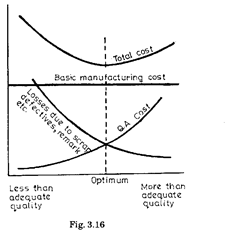3.17.
Quality can be defined as the degree to which an item satisfies the given need it was designed
to fulfill, i.e. its fitness for the purpose. As regards customer (actual user of product), quality product
is one which satisfies the desired appearance and finish, the price and value for money, criterion
of fitness for the purpose, and good after sales services.
Good quality can be attained only when both the
qualities of design and conformity are good.
Quality Assurance (QA) is concerned with all
the functions and activities concerned with the attain-
ment of the required quality. QA ensures improved
quality and gives the guarantee to the user that the
product manufactured will do what they are supposed
to do, and be safer, more reliable and will last longer.
Quality control (QC) is the practical means of
sustaining the product or service quality and ensuring
that it meets the specified requirements. QC is defined
as a system for programming and coordinating the
efforts of various groups in an organisation to maintain
or improve quality, at an economical level which allows
for customer satisfaction. QC is an integral part of QA.
Since QC is based on measurements so metrology is an
important tool of QA.

On the manufacturing side, quality goods mean—less repairs, reduced replacement costs
and reduced capital tie-up in spare stocks; and reduced losses from rejects and subsequent re-work
or scrapping of faulty items from despatch.
QA programme costs money but after an optimum level, the economic gains by QA are offset
against the cost of QA. Referring to Fig. 3.16 it would be seen that upto the optimum point of
minimum total costs a small amount spent on QA causes a comparatively big decrease in losses due
to poor QA. Upto this optimum point, quality is cheap when the gains are considered. The optimum
quality depends on how much effort (time and money) one is willing to place on QA. The area to the
right of the optimum point where quality begins to become uneconomical is usually only ventured
into when life support equipment is being considered. In these cases, perfection is desirable, which
proves expensive.
QA depends not on QC alone but on the activities of an entire company. QA scheme begins
with the proper identification of the customer’s needs. These have to be converted into adequate
designs, followed by the procurement of the necessary materials and conversion into the finished
product.
The basic elements in QA are essentially—
(i) Specification/standards and design — Involving the development of specification,
standards and designs
(ii) Materials and component control — Involving quality control and measurements
(iv) Manufacturing process control —do—
(iv) Market and servicing — Involving feedback and after sales service.
Metrology in Quality Assurance (Metrology)
Next post: Setting up a QA System (Metrology)
Previous post: Calibration Systems Requirements (Metrology)
